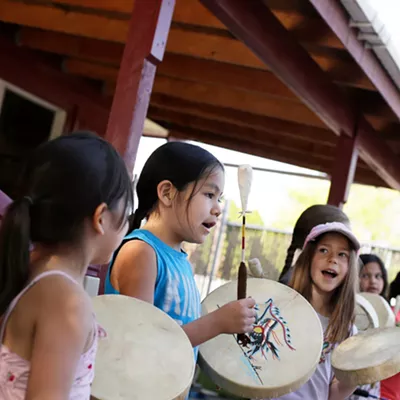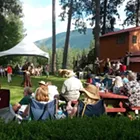In Kashgar, along China's ancient Silk Road, Beijing is a distant dream. Here in China's Wild West, the Mediterranean is closer than the China Sea and you're as likely to see a yak or a camel as a bicycle. Most of the region's residents follow Islam, although other religions - Buddhism, Zoroastrianism and Nestorian Christianity - have flourished at various times in the city's history. Politically, Kashgar is part of China, but culturally the place is a mix of Central Asian, Indian, Persian and Arab influences.
Out of this diversity springs the inspiration for Ancient Threads, Newly Woven, an exhibition of recent paintings and drawings from artists in northwestern China, from the cities of the fabled Silk Road. Created by the Meridian International Center, an organization dedicated to cross-cultural exchanges between China and the United States, Ancient Threads brings to life this region that most Americans know little about. After four months at Meridian's home base of Washington, D.C., Spokane is the first stop on the exhibition's traveling schedule.
"That makes it really special for us, because it comes to us direct from the source," says Jochen Wierich, the MAC's art curator. "The fascinating part of the Silk Road is that it's a region where all these cultures intersect, and we're just learning to appreciate that. I think generally our knowledge of China is focused on the eastern part, near Beijing."
The cities of the Silk Road seem remote now, because of their distance from the prominent population centers of eastern China, but these places have served as cosmopolitan trading centers since the time of the Roman Empire. Caravans moved along the trading routes that linked China with Mediterranean ports, carrying music, art and ideas as well as silks and spices. Centuries before Marco Polo began his travels, the cities of Kashgar, Urumqi, Dunhuang and Lanzhou rose as vibrant market towns along the great east-west trading route, skirting the deserts and marking passes through the mountains. In 742 AD, the city of Ch'ang-an (now known as Xi'an) - the eastern terminus of the Silk Road - had a population of 2 million people.
In keeping with the diversity of the region, the exhibition features a wide variety of painting styles, materials and techniques. The show is organized geographically, from west to east, and this layout emphasizes the continuum from Central Asian and Middle Eastern influences to more traditional Chinese images. The quality of the work ranges along a continuum as well -- but in a show like this, the context from which the paintings emerge is as important as precise Western standards of artistic merit.
"These paintings are made by people who don't have the means to go to art academies and get the training that we'd expect," says Wierich. "These are very different ways of producing art, often passed down from within families."
The artists of Kashgar use bright, vivid colors to depict people engaged in traditional activities. Particularly expressive are the "farmer paintings" from nearby Makit County, paintings created by untrained and often unidentified artists in the rural countryside. Like folk art everywhere, these works display the raw emotion and experience of the artist without relying on art school techniques to express ideas. Yet even these humble images come out of a cultural and political context.
"I love those farmer paintings," says Wierich. "The images come straight from the heart. But they've also become a showpiece for the government. All of these works come from a society where there's a lot of government involvement, and everything is mediated that's traveled through the government. But there are different levels of mediation, and I think this is truly an effort by Meridian to bring our attention to a region that hasn't been covered. That's the whole reason why we were attracted to this -- it's completely unique, and it brings uncharted territory to Spokane. It will familiarize people with a part of the world that's almost completely unknown."
As one moves further east in the exhibition, more elements from traditional Chinese art forms enter the picture: a woodcut from Urumqi; pen and ink from Dunhuang; scroll calligraphy from Xi'an. But even when the treatment is traditionally Chinese, the subjects reflect the people, the culture and the landscape of Central Asia, a part of the world with a history as rich and colorful as a bolt of Chinese silk.
Publication date: 08/05/04















